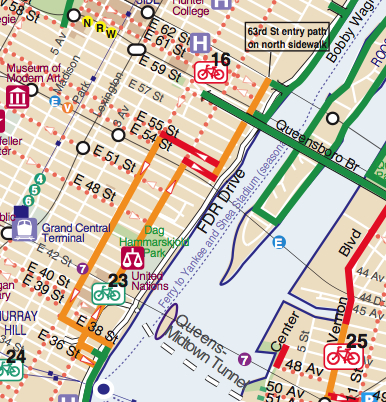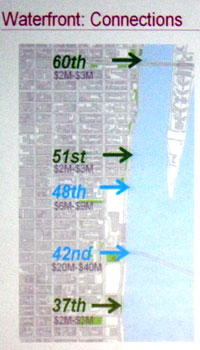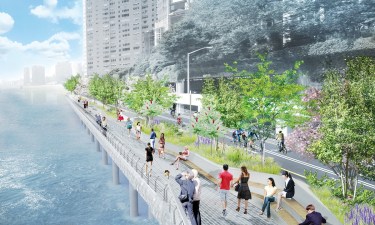City Bigs, Local Electeds Back Deal to Bridge East River Greenway Gap
On Sunday, a group of city officials and East Side electeds made their case for a deal to close the gap in the East River Greenway, addressing a full auditorium at the Schottenstein Cultural Center on East 34th Street. The deal has several moving parts, but the major takeaway was that the Bloomberg administration and a large group of legislators want to make the greenway happen.
 Closing the greenway gap would provide an uninterrupted bike path from Ward’s Island to the South Street Seaport. Image: The East River Greenway Initiative
Closing the greenway gap would provide an uninterrupted bike path from Ward’s Island to the South Street Seaport. Image: The East River Greenway InitiativeCurrently there is no greenway between 60th and 37th Streets — a huge gap around the United Nations campus that forces cyclists on the East Side into some of the most harrowing traffic in the city. The linchpin of the deal unveiled Sunday involves trading city land for U.N. financial support to build the greenway connector.
The city would sell the western part of Robert Moses Playground, a rectangle of asphalt at the corner of 41st and First Avenue. An area that attracts occasional recreational use would be annexed. Space used for a dog run, handball and basketball courts would not be touched. In turn, the U.N. would pay the city $150 million, mainly for the right to construct a new building the same height as the current U.N. tower. The funding would be used to complete the East River waterfront esplanade and plug the greenway gap.
A succession of local electeds spoke in favor of the deal, including State Senator Liz Krueger, Assemblymember Brian Kavanagh, City Council Member Daniel Garodnick, and Congresswoman Carolyn Maloney, who told the crowd, “I want to ride my bike there.”
The details of the plan were fleshed out by Parks Commissioner Adrian Benepe and Madelyn Wils of the NYC Economic Development Corporation.
Benepe said the new greenway segment would be a no-frills affair, like the recently completed connector on the Hudson River near Riverside Park. He also emphasized that without funding from the U.N. land deal, the project could not move forward. In addition to closing the greenway gap, he identified a package of public space enhancements the city can provide to offset the loss of part of Robert Moses park:
-
 As part of the deal to close the greenway gap, the city could improve pedestrian access to the waterfront at several points.
As part of the deal to close the greenway gap, the city could improve pedestrian access to the waterfront at several points.Expanding Asser Levy Park into the roadbed of Asser Levy Place, between 23rd and 25th Street, which adds roughly the same amount of parkland as would be lost;
- Converting the former Con Ed site at the 38th Street pier into a park, which could be paved over and devoted to the same uses as the annexed segment of Robert Moses Playground;
- Improving pedestrian access to the waterfront, including, potentially, an overpass at 51st street;
- Greening certain areas of the Queens Midtown Tunnel plaza, which might make those areas suitable for some form of recreation.
According to Wils, the window of opportunity to act on this deal is brief. The U.N. is looking to decide where to build their new tower this year, and while they prefer the Robert Moses Park site, they have other options at their disposal.
When it came time for the public to weigh in, comments applauding the deal outnumbered opposition by about two to one, according to my rough tally. (Full disclosure: I testified in favor of the deal in my capacity as a member of Upper Green Side.)
Most opposition stemmed from nearby residents who claimed that Robert Moses Playground is an irreplaceable space for playing ball games — uses that would seemingly be preserved in the deal described by Benepe. A few others lumped the new U.N. building together with towers planned by developer Sheldon Solow for a nearby site, which they argued would change the character of the neighborhood.
The next step comes tomorrow, when Community Board 6 discusses the proposal and is expected to put forth a resolution including the conditions they would place on their support for any plan. If the conditions are too onerous to be feasible, it could scuttle the deal. If they’re practical and reasonable, legislators can say they have the full support of the community for a specific plan, which they can enshrine in the legislation necessary to enable the completion of the greenway.
